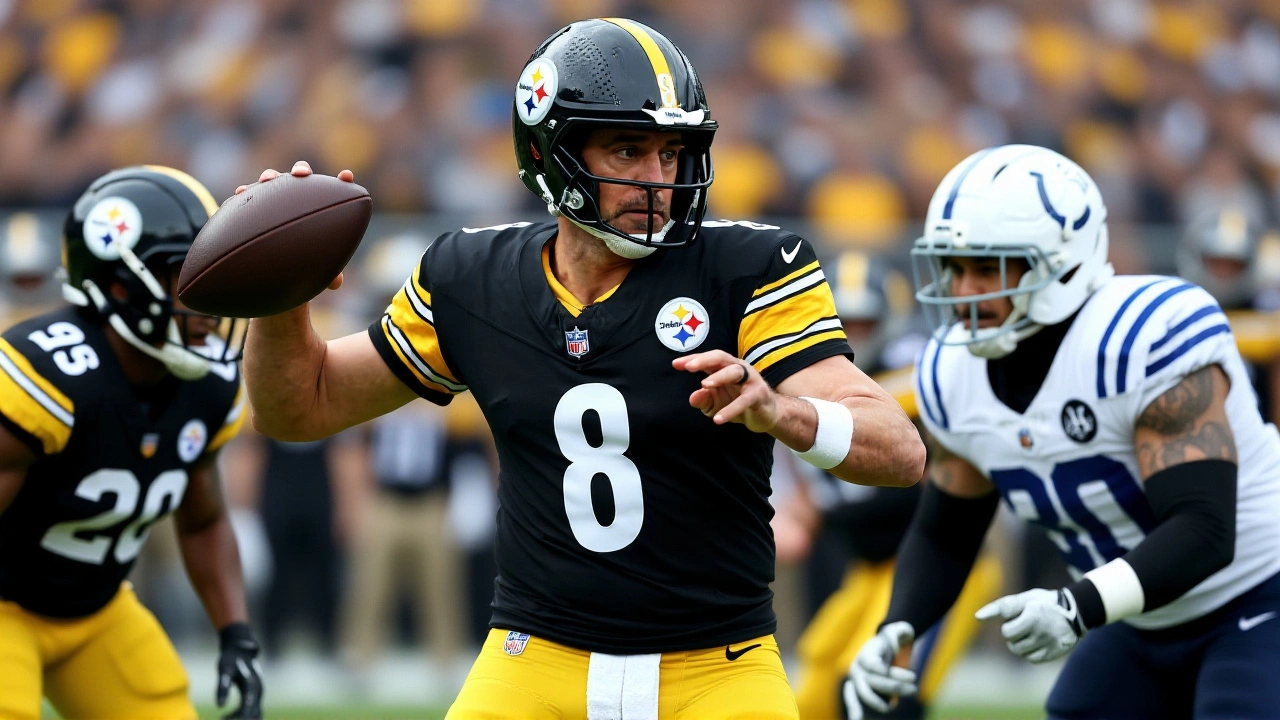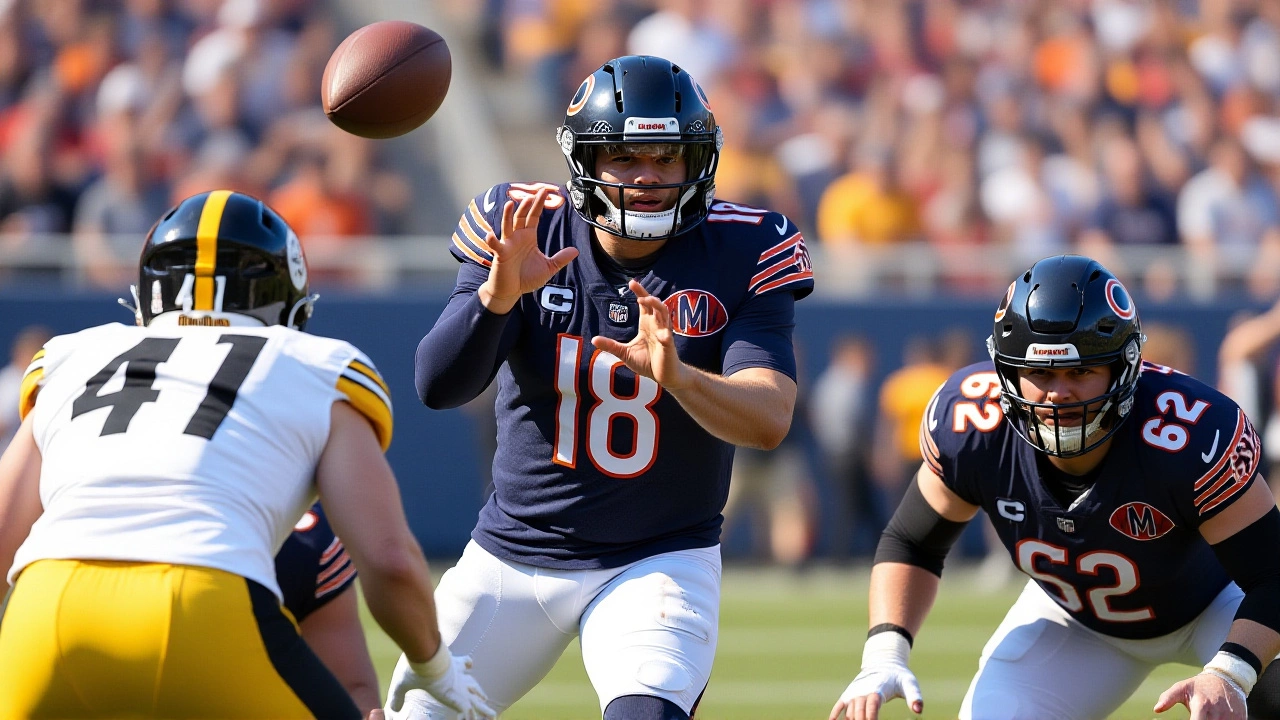- 0
When Caleb Williams launched a 42-yard strike to DJ Moore with 8:12 left in the fourth quarter, the roar at Soldier Field wasn’t just for the touchdown—it was for the transformation. The Chicago Bears had just taken a 31-21 lead over the Pittsburgh Steelers, and for the first time in over a decade, Chicago wasn’t just competing in the final minutes—they were dominating them. The final score, 31-28, on Week 12 of the 2025 NFL regular seasonChicago, Illinois, wasn’t just a win. It was a statement.
From Trailing to Dominating
Down 21-14 late in the second quarter, the Bears looked like they were heading for another heartbreaker. The Steelers’ offense, led by Mason Rudolph, had carved up Chicago’s secondary with crisp slants and quick outs. But then came the turning point: a 17-point unanswered surge. Caleb Williams found Darnell Mooney on a crossing route for a 12-yard score just before halftime. Then, in the third, Montez Sweat sacked Rudolph for a four-yard loss on third down, forcing a punt. Two plays later, Williams hit Moore again—this time on a deep post—for a 38-yard touchdown. The defense, long criticized as brittle, held Pittsburgh scoreless in the third quarter for the first time all season.
The Nemesis Who Wasn’t There
Everyone expected Aaron Rodgers to be on the sideline—not as a coach, not as a commentator, but as a ghost haunting the narrative. The Aaron Rodgers angle had been building since Week 1, when Williams, in his rookie season, threw a pick-six to the Packers that cost Chicago a win. Rodgers, now retired from playing, had become a symbolic foil: the veteran legend who once tormented Chicago’s quarterbacks, now watching from afar as his successor stepped into the spotlight. "He hoped he’d get a chance to chat with Aaron Rodgers," noted the Associated Press. "He got his opportunity after he led the Bears to yet another close win." The irony? Rodgers wasn’t even in the building. He was recovering from a shoulder injury in North Carolina. But his shadow? Still loomed large.
Defensive Identity Reborn
"They are not the same old Chicago Bears," blared commentator Kevin Byars in the YouTube highlights. And he wasn’t wrong. The Bears’ defense, once among the league’s worst in 2023, now ranks 11th in points allowed (292) and 9th in third-down efficiency. Montez Sweat had three pressures in the second half alone. Safety Jaquan Brisker intercepted Rudolph’s desperation heave with 42 seconds left, sealing the game. This wasn’t just about Williams’ arm—it was about a unit that finally believed. After allowing 30+ points in five of their first eight games, Chicago has held four of their last five opponents under 24. That’s not luck. That’s coaching. That’s culture.
Divisional Implications
With the win, the Chicago Bears improved to 8-3, maintaining a half-game lead over the Green Bay Packers (7-3-1) in the NFC North. The Steelers, at 6-5, remain tied with the Baltimore Ravens for second in the AFC North—but their road woes (2-3 away) are now a glaring issue. With games against Cincinnati and Cleveland still ahead, Pittsburgh’s playoff hopes hinge on winning those, then pulling off an upset in Green Bay. Meanwhile, Chicago’s schedule eases: home games against Detroit and Minnesota, then a critical December showdown with Green Bay. If they win out, they’ll host a playoff game for the first time since 2018.

What’s Next?
Williams, now 8-1 in his last nine starts as a starter, is being mentioned in MVP conversations. His 28 touchdown passes this season rank third in the league. But the real story isn’t just his stats—it’s his poise. On third-and-10 with 1:30 left, he took a snap from his own 15, rolled right, and fired a laser to Moore for a 14-yard conversion. No panic. No hesitation. Just execution. Meanwhile, the Steelers’ offense, which averaged 26.8 points per game in November, managed just 7 in the second half. Rudolph completed 26 of 38 passes but threw two interceptions and lost a fumble. The question now: Can Pittsburgh’s offense adjust before the playoffs? Or is this the end of their window?
Historical Context: Bears’ Resurgence
It’s easy to forget how far the Bears have come. In 2022, they finished 3-14. In 2023, they were 4-13. Even last year, they were 8-9 and missed the playoffs on tiebreakers. This season? They’re on pace for their best record since 2010. The hiring of head coach Sean Payton in 2024 was the spark. The drafting of Williams with the first overall pick was the fuel. Now, the defense is catching up. The special teams—once a liability—are now reliable. The Bears aren’t just winning. They’re winning in ways that suggest sustainability: ball control, timely defense, and clutch quarterback play. They’re not a fluke. They’re a franchise reborn.
Frequently Asked Questions
How did Caleb Williams perform compared to past Bears quarterbacks?
Caleb Williams became the first Bears quarterback since Jay Cutler in 2011 to throw three touchdown passes in three consecutive games. His 8-1 record as a starter is the best by a Bears QB through their first nine starts since Sid Luckman in 1943. He’s also the first rookie to lead the Bears to eight wins since Jim Harbaugh in 1987. His 68.3% completion rate and 9.4 yards per attempt are franchise-best marks for a first-year starter.
Why is Aaron Rodgers called Williams’ nemesis if he didn’t play?
Rodgers, as a Packers legend, was the face of Chicago’s quarterback struggles for over a decade. He threw for 17 touchdowns and zero interceptions in six games against the Bears from 2010 to 2020. Williams’ first NFL game was against Green Bay in 2024, where a late Rodgers-led drive sealed a 27-24 Packers win. The narrative stuck—even though Rodgers is retired, he symbolizes the era of heartbreak Chicago’s new QB is now overcoming.
What does this win mean for the NFC North race?
The Bears now hold a half-game lead over Green Bay and a full game over Detroit and Minnesota. With head-to-head tiebreakers in play, Chicago’s win over the Packers in Week 10 gives them the edge. If they win their final three games—including a December 22 rematch with Green Bay—they’ll clinch the division outright. A loss to the Packers would force a tiebreaker scenario, likely decided by point differential.
How did Montez Sweat impact the game?
Sweat recorded 2.5 sacks, 3 QB hits, and forced a fumble that led to Chicago’s first touchdown. His pressure on Rudolph in the third quarter forced a three-and-out that shifted momentum. Since being traded from Washington in 2024, Sweat has 18.5 sacks in 17 games—the most by any Bears defensive end since Richard Dent in 1985. He’s become the anchor of a defense that’s now among the league’s most improved.
Can the Steelers still make the playoffs?
Yes—but it’s unlikely. Pittsburgh needs to win all four of their remaining games, including matchups against division rivals Cleveland and Baltimore. They also need help: both Ravens and Bengals must lose at least two games each. Their 274 points scored rank 14th in the NFL, and their defense ranks 27th. Without a dramatic turnaround, their playoff chances drop below 20% according to FiveThirtyEight’s projections.
Is this the start of a new Bears dynasty?
It’s too early for dynasty talk—but this is the clearest sign of a rebuild succeeding since the 1985 team. With Williams under center, Payton calling plays, and a young defense rising, Chicago has its core. The offensive line, though still inconsistent, is improving. The front office has draft capital through 2027. If they keep drafting well and staying healthy, they could be a consistent contender for the next five years.

